The Miracle of the Practice
By Juliet Hwang, True Emerald Ocean
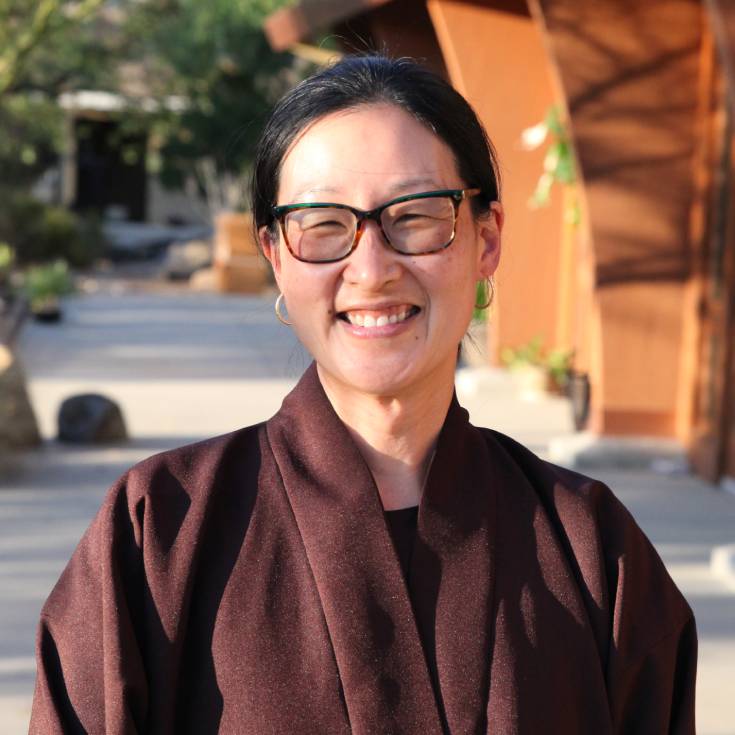
My father brought me to the practice. I grew up in a house shattered by violence, addiction, and mental illness. I felt sad and alone and often hid under my blanket in fear of the next outburst of violence. Growing up in a Catholic household, I felt guilty for the anger I felt towards my father and was told to recite Hail Marys and Our Fathers as penance for my sins. As I got older, that anger festered and I stopped talking to my father. I channeled my energy into activism. I protested against the war in Iraq, US military occupation in Korea, and police brutality in New York City while going to medical school. I wanted to learn how to heal myself, my patients, and my community.
Thay became the gentle, unconditionally loving father figure I had always wanted.
In medical school and residency, I learned how broken the health care system was and the limits of physicians. I witnessed the lack of resources for communities of color, especially in El Barrio in East Harlem and Elmhurst, Queens. I witnessed the impact of poverty, racism, and trauma in the bodies of our children and how the medical system never addressed the root causes of these issues. I saw how the trauma manifested as disease and cancer in children. It was under these conditions that my friend recommended I join her for a retreat in California. I am so thankful for her and the conditions that allowed me to fly across the country and meet the sangha for the first time.
I first met Thay at the first People of Color Retreat, “Colors of Compassion,” at Deer Park Monastery in March of 2004. I had read several of Thay’s books but it wasn’t until I actually practiced with the sangha that I deeply felt the impact of the miracle of mindfulness on my body. That first night during the orientation talk in the Ocean of Peace Meditation Hall, I don’t remember exactly what Thay said, but I remember how my body felt. I heard him talking about how to hold our suffering. Perhaps it was the gentle tone in his voice, or the compassion from his heart, but my body melted and I started to sob. My suffering had finally surfaced and flowed out of my body in the first place I had felt safe and held. That night, I knew I had found my teacher and my path, and I have stayed with the sangha over the past 18 years. Thay became the gentle, unconditionally loving father figure I had always wanted. I learned that I needed to heal the suffering in my heart before I could heal others. And I could not heal without the energy of support of the Buddha, the Dharma, and the Sangha.
I like to say I grew up in the sangha. And I am so proud to say that my two children love Deer Park as much as I do and are growing up embraced by the mountains as well. I couldn’t have done it without my supportive and loving husband.
Over the past 18 years, the anger towards my father has ebbs and flowed and has transformed at different times. The practice helped me cradle my suffering, look deeply, and hold myself and that little girl in compassion. It has also helped me look at my father with the eyes of compassion. The past few years, I have learned more about trauma-informed practices and the neurobiology of trauma. I have learned to see my father who was also suffered as a young child and was the vessel of intergenerational trauma from my ancestors and colonization. He didn’t know how to take care of that suffering. His nervous system was too overwhelmed. He was unskillful. He didn’t have the resources that I did to learn how to hold and transform it.
During the past three years of the pandemic, lots of old suffering has surfaced and I have returned to the many resilience practices I have developed over the years. My family and I have gone camping many times to return to the loving energy of Mother Earth. I have written poetry and painted with my children. We have made up countless songs and had dance parties in the living room. I have realized all my resilience practices, I learned from my father. He took us camping every summer. He took me to the Metropolitan Museum of Art for the first time in third grade and sparked my love for art. He played Schubert’s Trout Quintet in the house all the time and I fell in love with music.
The sangha has watered the seeds of bodhicitta over these decades. I am finally able to see my father for who he is and who he was. Doing his best as an immigrant physician facing racism and raising a family in a country where he didn’t speak the language. Before my lamp transmission ceremony in October of 2021 to become a dharma teacher in Thay’s lineage, I reached out to my father and wrote him a letter, thanking him for all he has taught me. I invited him to my ceremony, and he appeared on Zoom. My sisters and mother were surprised.
Since then, we have exchanged letters and texts. When I heard about the news about Thay’s passing, I went down to Deer Park to be with the sangha and grieve together. Tuesday afternoon, I was laying in my hammock, looking up at the oak tree in the campground. Suddenly, I got a text alert. “I heard about the passing of your teacher. How are you dear Hyun Jung? You must be in deep sorrow.” I saw his words and I instantly started sobbing, rocking the hammock, back and forth. My body started shaking and I let it shake. At one point, my chest started to rise. My heart cracked wide open and love just overflowed. Nothing mattered anymore. When my sobs calmed down, I picked up my phone and called my father. I heard his voice: “I was camping and just came back and heard the news about Thay.”
I sobbed immediately. “Thank you for reaching out.” I couldn’t stop crying. “Saranghae ahbah. Love you. That’s it. I love you.” I cried for a few more minutes.
His voice was shaky, “Time heals everything. It’s OK,” he said. We cried together. “I want to come and visit you in the spring and see the desert flowers bloom.”
“I love you ahbah. I’ll see you soon,” I replied, and we said goodbye.
I wailed some more, allowing my body to release everything inside.
Thay had brought my father back to me. Now that Thay had passed, my father was there to help hold me for the first time. I had witnessed the miracle of the practice. I know Thay is breathing and walking with me. I will take Thay with me when we see the desert cacti bloom this spring, as all of nature sings and stretches in gratitude.
Expect Nothing Short of Whatever Arises
By Jacqueline Kim, True Beautiful Garden
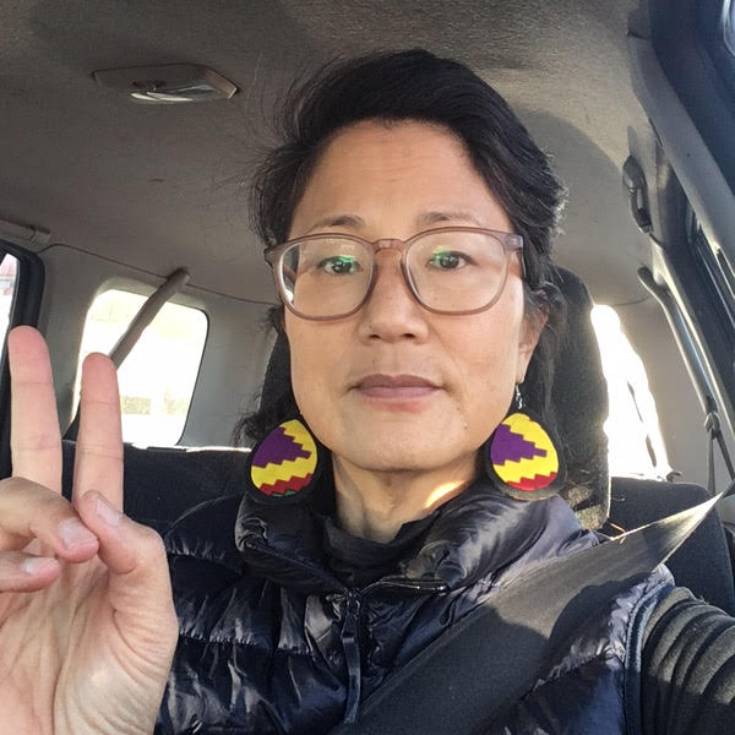
The day after Thay ceased manifesting on a physical plane, I drove myself to Deer Park Monastery, a beloved place and community I have been a part of for over 20 years. Two years into the COVID pandemic, I hadn’t visited in quite a while. I was also experiencing some heart arrhythmia, and having no nuclear family of my own, had suffered from the all-too-brief periods of connection being in a pod could afford. Deer Park Monastery sits nestled in hundreds of acres of dry, desert mountain. To go anywhere, you ascend or descend a steeply raked earth, which reminds you to go slowly, and every bit of the land — the trees, the rocks, plants, animals, and ground — feels and emits love. It was in the midst of this that I discovered what I was actually lonely for: an undeniable connection to something vast. As time on this mountain will prove, the earth is not only a setting. It plays an active part in our intelligence.
Thay expected nothing short of whatever would arise.
At a lunch in the meditation hall, Thay Phap Dung, one of the most senior monks, told us that one of the last things Thầy was teaching was synchronicity — he wanted the nuns and monks to learn to breathe together. This happens naturally when the bell rings, and when we sing, which both occur often at the monastery. And after a few days, when one’s conditions for suffering loosen, and one can merge with the rhythm of the sangha, more things start to happen. I’ll see someone I was just thinking about, a dish at the lunch table will appear that I was hoping to eat, an insight arrives about something I wasn’t focusing on. This effortless way at arriving at and between things nourishes me on a deep level, affirming that connections are there — many of them — we just might not see them. I think this was why Thay could speak with pauses that were truly empty. He expected nothing short of whatever would arise. How I will miss this, and will seek to place it in the center of my aspirations. I am deeply grateful to the incredibly dedicated monastic sangha for cultivating and protecting this material and energetic world where transformations can sprout and manifest.
The Beauty of Thay’s Teachings
by Jane Duong, True Joyous Peace
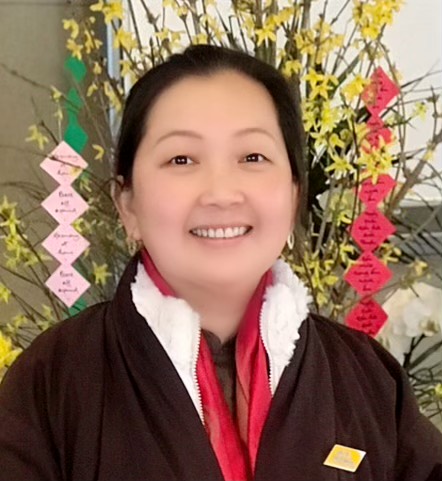
The evening at 00:00 hour Pacific Time, the crossing over between Thursday January 20th and Friday January 21st, 2022, I could not sleep and the following words came out of my heart, not knowing of the near imminent future of Thay’s body departure from this world:
“If one day the impermanence shall come upon us, let us continue to breathe and enjoy the breathing, continue to walk and enjoy the walking, under the beautiful brightness of the moonlight and during its absence. The moon is always here for us.”
In 2009, during a question & answer session at the Winter Retreat at Deer Park Monastery in Escondido, California, the question was asked: “How can I practice better at the times when I get very deeply depressed and lonely, no matter how much I practice mindful moments to be happy?”
It is important to accept your suffering as it is to accept your non-suffering.
This question resonated with me. I, too, was struggling with the everyday life challenges. There was my work as a professional female health clinician, and life, with motherhood to my children, daughterhood to my aging mother, partnership with a man whose heart is grander than mine and whose love language is acts of service, whereas mine is words of affirmation. There have been times of suffering. Yet everyday I thrive to some extent, even while suffering.
Thay’s answer struck me to my core, even to this day twelve years later. He said, “At Plum Village, during the summer, we gather dry woods on warm sunny days and store them. When it snows or storms outside, we use the wood to keep us warm. We enjoy watching snowfalls. We also enjoy playing in the snow, knowing the wood would keep us warm and dry, knowing spring will return and soon summer will arrive.” That was Thay’s reply —poetic, simple, realistic, practical and layered in depth. This is because that is. We inter-are. Suffering is one of the four noble truths.
Many times I had heard Thay’s teachings about the Four Noble Truths and interbeing, yet it all came in one ear, and out the other ear until the moment I heard this response to the question above. Everything I heard or read was a concept, until it becomes a consistent practice for everyday living.
It is important to accept your suffering as it is to accept your non-suffering. Words need action to make oneness. Concepts and practice make possibility, make oneness wholesome. That is the beauty of Thay’s teachings, simple, realistic, poetic, yet many layers of depth waiting for us to learn from.
The Foundation of Liberatory Work
by Meena Srinivasan, True Seal of Peace
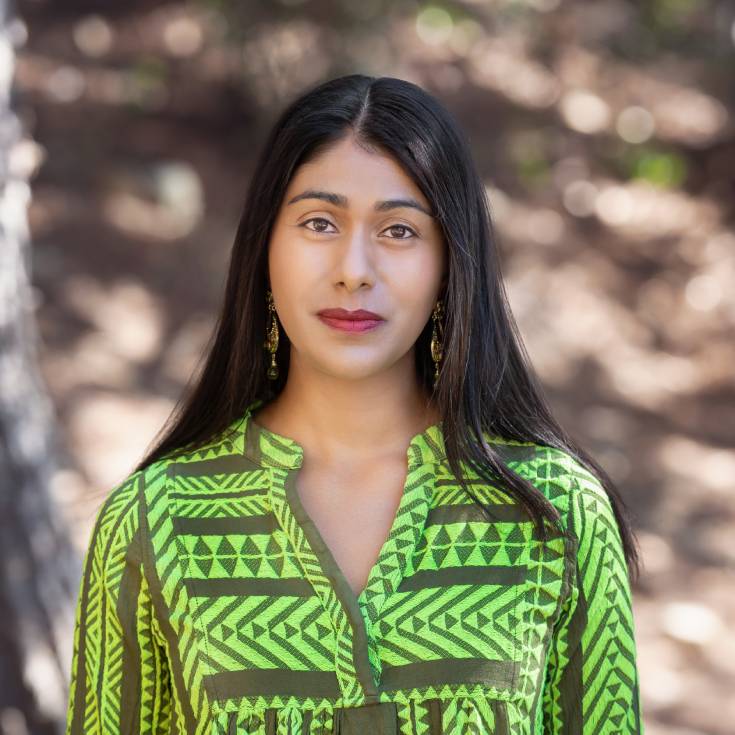
I was born and raised in the United States but was inspired to spend ages 26-31 living in my ancestral homeland of India to deepen my study of Indian philosophy, yoga and contemplative practices. I grew up in a Hindu family and I wasn’t looking to take refuge in the buddhadharma, but in Thay’s presence I was hit by a force of love — I knew deep in my heart that I had found my true spiritual home. My most powerful experience of Thay was a talk he gave on the anniversary of Gandhi’s birth at the site of his martyrdom and this evening changed my life forever. In the days that followed I went everywhere with the mahasangha.
I’m an educational leader and I’ve been honored to contribute to Thay’s books, Planting Seeds: Practicing Mindfulness with Children and Happy Teachers Change the World. I am blessed to have Thay offer the foreword for my own book, Teach, Breathe, Learn: Mindfulness In and Out of the Classroom.
There is no greater life purpose than to strive to embody your teachings.
During my time in India, the country was rocked by numerous bomb blasts fueled by fundamentalist thinking. In the fall of 2008, when Thay was visiting, New Delhi alone had been the site of five deadly attacks injuring more than 100 people and killing close to 25. My most vivid memory of this time is walking with Thay for peace from Vijay Chowk outside of Parliament, to India Gate. As we walked in silence trying to cultivate peacefulness within so that we can be peaceful in the world, I felt a deep sense of hope despite all of the bloodshed and violence my adopted city faced. In that moment, my mission as an educator became crystal clear. Teachers are not only a vital link in creating “the change we wish to see in the world,” but must fundamentally embody this Gandhian vision. Education is the vehicle for building a more peaceful, compassionate and just world.
The American Embassy School I was teaching at in India had an educators sangha started by my teaching colleagues and Dharmacharya Shantum Seth, one of Thay’s senior students. Thay’s visit breathed new life into our sangha when we got to attend a retreat called “Towards a Compassionate and Healthy Society,” along with 550 educators in Dehradun, India. Since this retreat, I have dedicated my life to Mindfulness in Education, Social and Emotional Learning (SEL), and now lead Transformative Educational Leadership (TEL), which is a beloved community of awakened educational leaders committed to inner personal development in service of outer systemic transformation. Thay’s teachings are the foundation of the healing-centered, liberatory work I’m engaged in with schools and school leaders. As a mother of a toddler, they are also the foundation of my parenting.
In the days since Thay’s transition I was able to spend time engaging in ceremonies at Deer Park Monastery with the mahasangha, being together in this way as I cried tears of gratitude has been a great gift. While partaking in the Memorial Pin ceremony at Deer Park the following words came to me as a continuation vow in honor of Thay:
Beloved Thay
You lit my Bodhichitta in my ancestral homeland
On the anniversary of Gandhi’s birth
At the site of his martyrdom
You taught me about No Birth, No Death, No Fear
As you invited us all to be the Mahatma’s continuation
Now your spiritual children are being called to be
Your continuation
There’s no greater honor than to be your spiritual daughter
No greater life purpose than to strive to embody your teachings and the insight of Interbeing
No greater aspiration than to walk in this world with your gentle, loving presence
I vow to walk the Bodhisattva path together with my brothers and sisters
I vow to continue your commitment to King of building Beloved Community
Knowing that Beloved Community also extends to our Mother Earth
I asked you once, “What’s faith?”
You told me, “Faith is having confidence in your capacity to fully awaken your Buddha nature”
Knowing that I can always touch your wisdom and love inside of me I have FAITH
I’m always held, the practice is my ultimate embrace, the sangha keeps my Bodhichittta lit
Buddham saranam gacchami
Dammam saranam gacchami
Sangham saranam gacchami
Thank You, Dear Teacher
by Leslie Davis, True Auspicious Dwelling
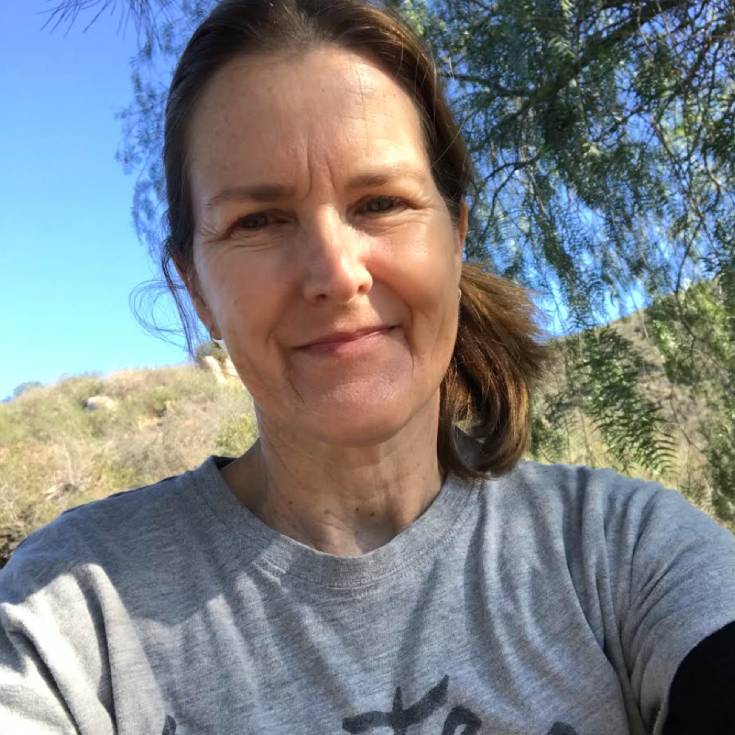
I spent part of Thich Nhat Hanh’s memorial week at Deer Park Monastery where I’ve been attending retreats and visits for more than 20 years with my family. It was a beautiful week of memorial ceremonies and practice opportunities, each day filled with shared time with the sangha, community practice, silent meals, and walking meditation in nature. Each day there were events to look forward to, a schedule to follow, plenty of time for personal reflection, and time to honor Thay. At the end of the week I traveled home and watched the livestream of the final Funeral Procession and Cremation Ceremony at home on my computer. I lit a candle for Thay and sat with the community virtually, missing the chance to share this legendary day in person with the sangha.
The next morning, I woke up feeling so down. The day after the funeral of my beloved teacher. There was an emptiness that overwhelmed me. Now what? Upon hearing the news on Friday, January 21, I went for a walk in nature and felt so light and free, so alive! I was truly in touch with the energy of Thay as I walked and saw the beauty in the plants, the trees, and the sunlight shining on everything. I felt so happy to be alive – so grateful to be walking on the earth at the same time as this magnificent teacher and human, so fortunate that my life path intersected with his and I was able to be his student for so many years and to raise my children as a mindful parent. I felt deep respect and gratitude for Thay for helping me transform deep suffering in my own life. But on this morning, the day after the cremation ceremony, I was so sad and felt lost.
I am his continuation, and the continuation of his spiritual ancestors.
Today was the first day since Thay passed that there is nothing planned. No ceremony. No livestream meditation. No activity to focus on. Now what? Now what do I do? A familiar refrain. The feeling of grief is very strong in me as I have had a lot of loss in my life. I found myself slipping into deep grief. I cried for a while. Then I remembered something Thay always said, and I’m paraphrasing… Thay says that as a practitioner you can live without fear, despair, and anxiety, because you know what to do. You know how to follow your breathing. You know how to sit, to practice walking meditation. You know how to hold your feelings and your suffering and be with them. You know how to smile. You know you can touch the present moment and feel sorrow and joy at the same time.
So I thought to myself, “I know what to do. I am a practitioner. I am Thay’s student. I am Thay’s continuation.” I got out of bed, washed my face, and began walking meditation right in my bedroom. I knew what to do. I took gentle steps. I followed my breathing. I came home to myself. I felt connected to the sangha, my beloved community. I felt Thay’s energy in my body. After walking with him and the sangha many times over the past 20 years I could easily bring the energy of his peaceful steps into my own.
Thay Pháp Dung said at Deer Park last week about our teacher’s death, “This is not a loss; it is a transfer of energy.” I felt this in every cell of my body as I did walking meditation in circles in my bedroom. I have Thay’s spirit and energy in me. I am his continuation, and the continuation of his spiritual ancestors. The gift of this awareness will help me heal from other losses I’m going through. Thank you, dear teacher, dear Thay, dear beloved community. I vow to live my life beautifully, to follow the path of love and understanding, and to offer compassion and joy to others.
A Cloud Never Dies
by Kerry Bennassar, True Unfolding Light
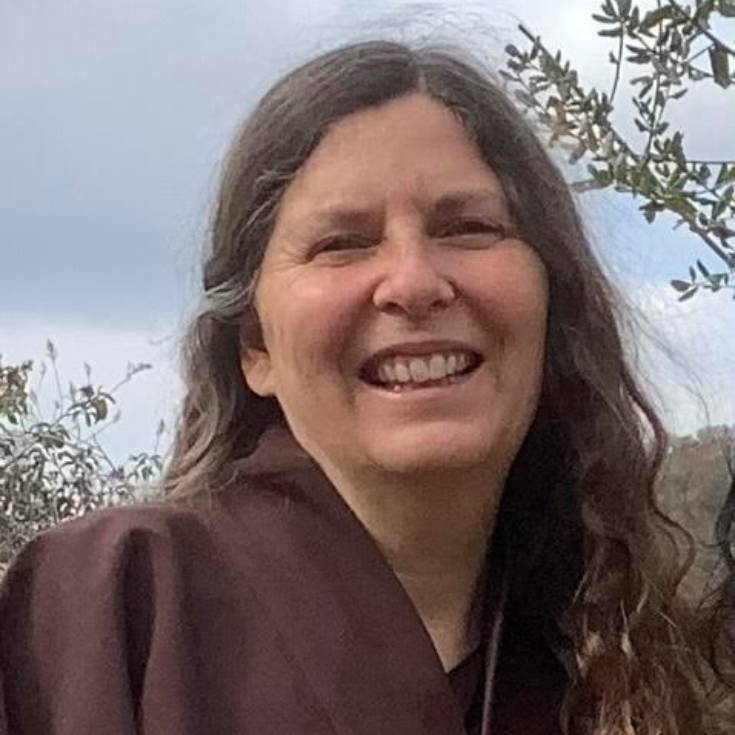
At Deer Park Monastery during the memorial ceremony week for Thich Nhat Hanh, we were invited by Thay Phap Dung (Dharma Embrace) to sit and eat in the big hall on the floor. He reminded us that Thay really enjoyed sitting on the floor to eat his meals. We set up the cushions in concentric circles in the Ocean of Peace Meditation Hall, and sat on the floor and ate lunch. A few people shared their memories and there was a woman who worked with Thay before he started his School of Youth Services in Vietnam in the 60s. She told stories about how Thay would rent a hut in a village and teach the children, which brought up memories of my own children at Deer Park. Beloved Thay loved visiting with the children and sharing a precious and lovely talk with them before the longer dharma talk, at which point the children would go play with the brothers and sisters in the children’s program. Thay’s sharing for the children was always filled with beautiful jewels of wisdom about flower petals, clouds, friends and family. The five-year-old child in me would lean forward in delight along with the kids.
I wish to water my children to grow into a great forest of compassion and love.
Thay Phap Dung, spoke about how planting a tree would be a beautiful memorial to Thay’s deep connection to nature and interconnectedness, and that nurturing a tree would be something that Thay would enjoy deeply. I am going to plant a flowering plum tree in my garden to honor Thay. I’m also going to have friends send me photos of a tree that they may wish to plant and nurture to honor Thay. And if a friend doesn’t have a garden, then maybe they can plant it at a friend’s house, or along the sidewalk in their town. Or nurture a plant.
I am going to continue supporting sangha and connecting new and old friends in the practice which was part of my deep aspiration during my process of becoming a member of the Order of Interbeing. I wish to wholeheartedly support the Wake Up Community, a community of younger practitioners ages 18 to 35, as well as being a loving mountain of solidity for my two teenagers. I wish to water them to grow into a great forest of compassion and love that will grow beautifully into the future.
For Thay:
Call from my beloved Dharma sister.
Walking
Veiled in a gauze of sadness and profound gratitude
The ferocious bloom of the camelia bush
stops me
in my tracks.
A blossom reaches out and cradles my heart
Such a pink have I seen before?
I have known you, bush, since I was five.
Crown of petals adorning, reveling in joy and abundance.
Singing out to me.
I am here.
Look.
Do you see?
A cloud never dies.






